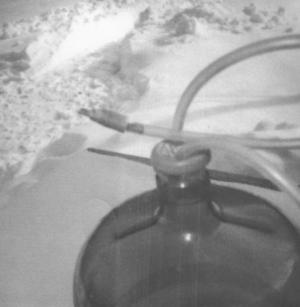2006 - Volume #30, Issue #1, Page #40
[ Sample Stories From This Issue | List of All Stories In This Issue | Print this story
| Read this issue]
Low Cost Maple Sap Collection
 |
"There's nothing like making your own maple syrup," explains DiChiaranti. "It's fun, and if you choose to, you can make a profit with very little start-up investment."
Instead of miles of plastic tubing draining sap back to collection tanks or metal pails hanging from individual taps, DiChiaranti recycles 5-gal. water cooler jugs. He inserts two short sections of plastic tubing into covers on the jugs. The other ends of the tubes are attached to homemade taps, which he inserts into holes drilled in the trees.
"I use 2-in. lengths of 3/4-in. dowel stick and copper tubing to make my taps," he explains. "I drill a hole in the dowel length to match the size of the copper tubing I am going to use, which in turn has to fit the plastic tubing."
DiChiaranti shapes one end of the dowel stick like a bullet tip, leaving the other end cut flat. He then inserts a 3-in. length of copper tubing into the dowel stick with a short tip extending out of the bullet end. This tip is cut at an angle to help insert it into the hole in the tree.
"The plastic tube fits snugly onto the copper tubing, flush against the dowel stick to prevent any leakage," says DiChiaranti. "Likewise, the copper tube has to fit tight in the dowel with no play."
When the jugs are ready, DiChiaranti sets them up near maple trees. He drills a hole at an upward angle into the south side of the tree and inserts the tap. University of Vermont Extension advises drilling a single tap hole 1 1/2 to 2 in. deep in trees 10 to 15 in. in diameter and two holes in trees more than 15 in. in diameter.
"It takes about 40 gallons of sap to make a single gallon of syrup," says DiChiaranti. "One tree can yield from one to three gal. per day. "
He advises using a bungee cord to secure the empty jug to the tree in windy areas. Otherwise the closed container system pretty well takes care of itself. One of the keys to quality syrup production is clean equipment, stresses DiChiaranti.
"Use water with a little bleach to clean equipment before and after each use," he says. "Detergent can leave a film or residue which can contaminate your syrup."
Contact: FARM SHOW Followup, Jesse Dean DiChiaranti, P.O. Box 51, Sterling, Penn. 18463 (ph 570 676-4008).

Click here to download page story appeared in.

Click here to read entire issue
To read the rest of this story, download this issue below or click here to register with your account number.




